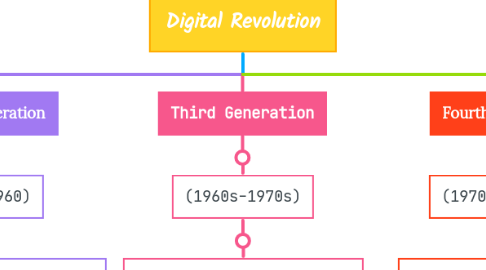
1. First Generation
1.1. (1940s-1950s)
1.1.1. Designed using a vacuum tube
1.1.1.1. Large and heavy, very slow speed data processing, consumed high electricity and generade a lot of heat
1.1.1.1.1. Used for calculation,storage and control purposes
2. Second Generation
2.1. (1950s-1960)
2.1.1. Designed using a Transitor
2.1.1.1. Smaller, faster, cheaper, more energy efficient
2.1.1.1.1. Assembly symbolic languages
3. Third Generation
3.1. (1960s-1970s)
3.1.1. Integrated Circuit (ICs) was used as the main electronic component
3.1.1.1. Transitors placed on a silicon chip
3.1.1.1.1. ICs advantages: large memory space and faster data processing
4. Fourth Generation
4.1. (1970s-present)
4.1.1. Microprocessor was the main component
4.1.1.1. Large scale integration: to perform arithmetic, logic and control functions on a single chip model
4.1.1.1.1. Smaller computer size but large and diverse data processing capacity
5. Fifth Generation
5.1. (Present and Beyond)
5.1.1. Based on Artificial Intelligence, Ultra Large Scale Integration and parallel processing method
5.1.1.1. Touchpad, touchscreen, pen, voice recognition and light scanner
5.1.1.1.1. Can understand the words spoken by childrens
